Fostex FE206En - Change in Frequency Response above 1000Hz due to Aging of the Suspension Material ?
About 15 years ago I designed a 2-way loudspeaker in which this popular and good sounded full range speaker in a sand-filled, closed box covers the range above 500Hz.
At the time of the first measurements, the peak between 2500Hz and 3200Hz was also straightened by an equalization network integrated into the high pass crossover network.
During a current check of frequency response, I note that the above mentioned peak both in the frequency response and impedance plot is a bit moved down than at the time of the design.
Which means, that the mentioned equalization parallel network (notch filter) no longer works in the right manner - go to the attachments (i. e. notch filter values must now be corrected).
I would be interested to know if this moved down peak in the frequency response is common resp. usual after a long time of use.
Maybe I didn't pay attention at that time to the fact, that the running-in resp. burn-in time was long enough when I start the design of the equalizer network (2-3 days were obviously not enough).
Thank you for any statements.
P.S.: Image No 1 shows the frequency response (SPL nearfield) without (blue) and with (white) passive crossover network/equalizer. Image No 2 the same, but for impedance. Image No 3 the frequency response at the place for listening include mid bass unit (Precision Devices PD121).
Image No 4-6 the loudspeaker set up without sub (this you will find in post #4 under
How Reliable Are McCauley Drivers?
and image No 7-10 other plots for frequency response of FE206EN found on the web.
About 15 years ago I designed a 2-way loudspeaker in which this popular and good sounded full range speaker in a sand-filled, closed box covers the range above 500Hz.
At the time of the first measurements, the peak between 2500Hz and 3200Hz was also straightened by an equalization network integrated into the high pass crossover network.
During a current check of frequency response, I note that the above mentioned peak both in the frequency response and impedance plot is a bit moved down than at the time of the design.
Which means, that the mentioned equalization parallel network (notch filter) no longer works in the right manner - go to the attachments (i. e. notch filter values must now be corrected).
I would be interested to know if this moved down peak in the frequency response is common resp. usual after a long time of use.
Maybe I didn't pay attention at that time to the fact, that the running-in resp. burn-in time was long enough when I start the design of the equalizer network (2-3 days were obviously not enough).
Thank you for any statements.
P.S.: Image No 1 shows the frequency response (SPL nearfield) without (blue) and with (white) passive crossover network/equalizer. Image No 2 the same, but for impedance. Image No 3 the frequency response at the place for listening include mid bass unit (Precision Devices PD121).
Image No 4-6 the loudspeaker set up without sub (this you will find in post #4 under
How Reliable Are McCauley Drivers?
and image No 7-10 other plots for frequency response of FE206EN found on the web.
Attachments
-
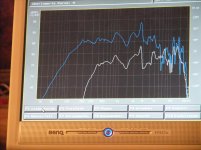 Fostex FE206EN Frequenzg. ohne-mit Filter.jpg1,020.1 KB · Views: 160
Fostex FE206EN Frequenzg. ohne-mit Filter.jpg1,020.1 KB · Views: 160 -
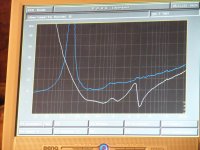 Fostex FE206EN Imp L mit-ohne Filter.jpg1,005.9 KB · Views: 164
Fostex FE206EN Imp L mit-ohne Filter.jpg1,005.9 KB · Views: 164 -
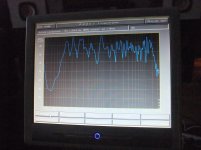 PD121+FE206EN L Summe ohne Sub.jpg1,004.8 KB · Views: 197
PD121+FE206EN L Summe ohne Sub.jpg1,004.8 KB · Views: 197 -
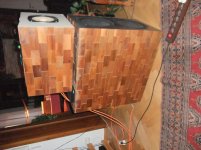 DSCF8130.jpg1,002.4 KB · Views: 166
DSCF8130.jpg1,002.4 KB · Views: 166 -
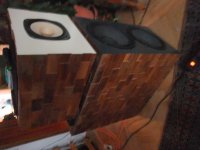 DSCF8127.jpg998.5 KB · Views: 156
DSCF8127.jpg998.5 KB · Views: 156 -
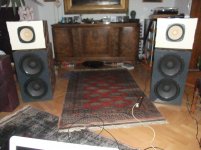 DSCF8124.jpg1,005.8 KB · Views: 102
DSCF8124.jpg1,005.8 KB · Views: 102 -
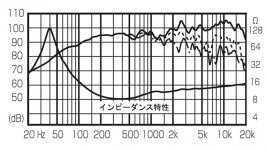 FE206En-F1.jpg97.7 KB · Views: 127
FE206En-F1.jpg97.7 KB · Views: 127 -
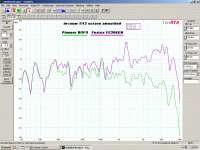 FE206EN.gif74.2 KB · Views: 118
FE206EN.gif74.2 KB · Views: 118 -
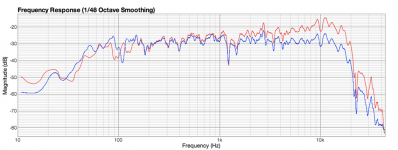 FE206E before-after-tuning.png167.7 KB · Views: 121
FE206E before-after-tuning.png167.7 KB · Views: 121 -
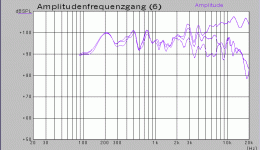 trumpet Fostex FE206E.gif17.3 KB · Views: 112
trumpet Fostex FE206E.gif17.3 KB · Views: 112
Last edited:
I don't have any response plots to hand, but yes, it's not unknown to see things like this with some [some] wideband drive units over the longer term.
Because these drivers produce much of their response through TL modes (aka breakup / resonance), the cones and suspension do progressively change over time through normal use (& hopefully minimal environmental wear & tear ). Most of the attention is given to changes in the suspension, but as noted, given the constant flex / resonance, cone profiles themselves can also change very slightly as fibres & adhesives move, or some work-hardening etc. occurs. This in turn can affect the resonant behaviour & frequency response. Lowthers for example (or at least some Lowthers), have a reputation for this amongst some of their longer-term owners.
). Most of the attention is given to changes in the suspension, but as noted, given the constant flex / resonance, cone profiles themselves can also change very slightly as fibres & adhesives move, or some work-hardening etc. occurs. This in turn can affect the resonant behaviour & frequency response. Lowthers for example (or at least some Lowthers), have a reputation for this amongst some of their longer-term owners.
Because these drivers produce much of their response through TL modes (aka breakup / resonance), the cones and suspension do progressively change over time through normal use (& hopefully minimal environmental wear & tear
Last edited:
Hmm, 1.4" dia. VC = ~3079 Hz, so this is all happening around the whizzer base, so apparently this area of the cone has had some of its starch worked out of it over time, so if you haven't done the $0.98 Lowther tweak, then a good plan to do it to smooth out that whole area once the right density is found and if already done, then redo it with greater density and/or make it bigger to cover more area of both the cone and whizzer.
FWIW, historically the first thing I did to whizzer cones was kneed the starch out and if I got carried away [too 'limp'/depressed output], then sprayed them with the cheapest lacquer based hairspray I could find since it was much denser for the big hairdos of the day to work my back to what sounded tonally balanced since I was taught to solve acoustic problems with acoustic solutions.
FWIW, historically the first thing I did to whizzer cones was kneed the starch out and if I got carried away [too 'limp'/depressed output], then sprayed them with the cheapest lacquer based hairspray I could find since it was much denser for the big hairdos of the day to work my back to what sounded tonally balanced since I was taught to solve acoustic problems with acoustic solutions.
check out post #55 under
https://www.diyaudio.com/community/threads/visaton-bg20-impressive-mod.408081/
https://www.diyaudio.com/community/threads/visaton-bg20-impressive-mod.408081/
- Home
- Loudspeakers
- Full Range
- Fostex FE206En - Change in Frequency Response Peaks above 1000Hz due to Aging ?